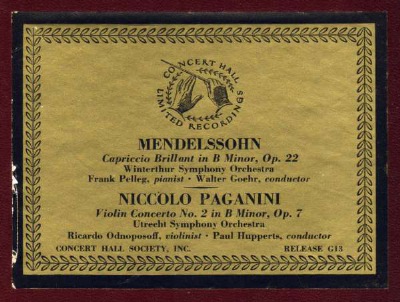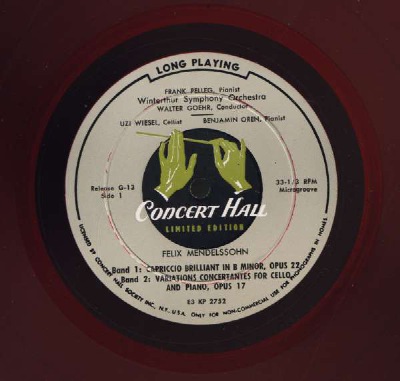 | 
Felix Mendelssohn Bartholdy, Capriccio brillant pour piano et orchestre en si mineur, Op. 22, Frank Pelleg, Sinfonieorchester Winterthur, Walter Goehr, Concert Hall Society Release G13
 Cette courte oeuvre de Mendelssohn - une durée d'une dizaine de minutes - est aujourd'hui un peu oubliée dans les salles de concert. Peut-être à cause de cette durée inhabituelle pour une oeuvre concertante avec soliste, qui - à cause de sa courte durée - se laisse mal intégrer dans un programme de concert. Et pourtant c'est une oeuvre splendide, qui mériterait d'être plus souvent jouée. Cette courte oeuvre de Mendelssohn - une durée d'une dizaine de minutes - est aujourd'hui un peu oubliée dans les salles de concert. Peut-être à cause de cette durée inhabituelle pour une oeuvre concertante avec soliste, qui - à cause de sa courte durée - se laisse mal intégrer dans un programme de concert. Et pourtant c'est une oeuvre splendide, qui mériterait d'être plus souvent jouée.
Mendelssohn compose une grande partie de cette oeuvre avant septembre 1831 (d'après la datation de son manuscript pour piano seul), et termine son orchestration huit mois plus tard, le 18 mai 1832 (d'après la datation du manuscript de la version orchestrale). Felix Mendelssohn lui-même en donne la première représentation le 25 mai 1832 à Londres.
Steve Lindeman écrit sur la position de ce Capriccio dans l'oeuvre de Mendelssohn:
"[...] The Capriccio is Mendelssohn's first attempt at a single-movement concerted work, consisting of a fast movement preceded by a slow introductory section. There is a interesting parallel to this conception with that of his concert overture, Calm Sea and Properous Voyage (Meerestille und glückliche Fahrt op. 27, 1829-35). In the overture Mendelssohn took pains to make clear that he regarded the Adadio, representig the Calm Sea, as the first of two disctinct tableaux, rather than as an introduction, leading to the subsequent fast section. This overture may thereby be seen as standing in a relationship to the symphony vaguely analogous to the Cappricio brillant's relationship to the concerto. A parallel also exists with a roughly contemporaneous work, the Rondo capriccioso. This work was conceived in 1828 as an étude, and reworked in 1830 as a present for Delphine von Schauroth, the dedicatee of the G minor Concerto. The Rondo capriccioso also consists of a lyrical Andante introduction, linked by a transition to the subsequent Presto. Todd notes the similarity between this design, "not unlike the condensed second and third movements of a concerto," and adumbrating similar procedures in the two piano concertos, the Capriccio brillant, and the Serenade and Allegro giocoso.
The influence of the Weber Konzertstueck, again, is felt in the Capriccio. Mendelssohn replicates almost exactly Weber's distinctively halting articulation of the Konzertstueck's introduction. Moreover, following a huge transition to the dominant of the relative major, the march-lite second theme (mm. 99ff.) is set off much more dramatically than in a typical concertoform movement. This creates the feeling that the music from this section (in U major) almost belongs to another movement.
This delineation is further emphasized by the fact that Mendelssohn initially scores the second theme for the orchestra alone (until m. 116), just as Weber had orchestrated the march in the Konzertstueck. This underscores the orchestra's distinct personality, far removed from that of the soloist, whose exclusive domain is the primary theme; the orchestra never formally states the primary theme, but merely accompanies the soloist's statements of it. This segregated disposition calls to mind the respective treatments of the secondary theme in both the Molto Allegro con fuoco of the G minor Concerto op. 25, and the revisions to the first movement of the E major Concerto for Two Pianos. [...]"
Cité d'après Steve Lindeman, "The works for solo instrument(s) and orchestra " dans "The Cambridge companion to Mendelssohn" de Peter Jameson Mercer-Taylor, 2004, Cambridge University Press, ISBN 0 521 82603 9 hardback, ISBN 0 521 53342 2 paperback , pages 120-121.
La partition peut être librement téléchargée sur la page correspondante du site de l'IMSLP.
L'interprétation que je vous propose maintenant est celle de Frank Pelleg, il est accompagné par l'Orchestre Symphonique de Winterthur dirigé par Walter Goehr. La première parution a lieu sur la première face d'un splendide vinyle rouge Concert Hall Release G-13 (tirage limité) vers 1951-1952, étant donné que la parution de ce disque est annoncée dans le 2e supplément du WERM - sur l'autre face du sique se trouve le 2e concerto pour violon de Paganini avec Ricardo Odnoposoff en soliste, accompagné par l'Orchestre Symphonique d'Utrecht sous la direction de Paul Hupperts.
À noter que le Capriccio brillant n'avait été à l'époque qu'assez peu enregistré. Avant cet enregistrement il n'y a eu que deux enregistrements, le premier avec Moura Lympany et Boyd Neel dirigeant le National Symphony Orchestra, le second avec Joanna Graudan et - on ne s'y attendrait pas... - avec Dimitri Mitropoulos dirigeant l'Orchestre de Minneapolis.
Voici donc...
Felix Mendelssohn Bartholdy, Capriccio brillant für Pianoforte mit Orchester in h-moll, Op. 22, Frank Pelleg, Sinfonieorchester Winterthur, Walter Goehr (Andante - Allegro con fuoco 10:57)
que vous pouvez obtenir en...
______________________________CLIQUANT_ICI______________________________
 Concert Hall Society Release G13, Release G-13 E3 KP 2752, CHGL 13 PT 1 E3 KP 2752 1A -> WAV -> léger à moyen DeClick avec ClickRepair, des réparations manuelles -> FLAC Concert Hall Society Release G13, Release G-13 E3 KP 2752, CHGL 13 PT 1 E3 KP 2752 1A -> WAV -> léger à moyen DeClick avec ClickRepair, des réparations manuelles -> FLAC
1 fichier FLAC et 1 fichier PDF dans 1 fichier ZIP
En complément et surtout pour le plaisir...
À peu près de la même époque date un autre splendide enregistrement, une interprétation toutefois assez différente, surtout au début: les 9 et 10 février 1954, au Kingsway Hall, Peter Katin a enregistré cette oeuvre pour Decca, accompagné par le London Philarmonic Orchestra sous la direction de Jean Martinon. Peter Katin aborde l'oeuvre d'une manière très différente:
Felix Mendelssohn Bartholdy, Capriccio brillant für Pianoforte mit Orchester in h-moll, Op. 22, Peter Katin, London Philharmonic Orchestra, Jean Martinon, 09/10.02.1954, Kingsway Hall, LXT 2932 (05/1954), LL 1007 (09/1954) (Andante - Allegro con fuoco 10:34)
Un enregistrement que vous pouvez obtenir en...
______________________________CLIQUANT_ICI______________________________
Radiodiffusion -> WAV -> FLAC
1 fichier FLAC et 1 fichier PDF dans 1 fichier ZIP
Un autre enregistrement splendide a été fait en 1960 par Gary Graffman, accompagné par le Boston Symphony Orchestra sous la direction de Charles Muench. Gary Graffman aborde cette oeuvre de manière assez semblable à Frank Pelleg. L'enregistrement a été fait en stéréo, je n'ai toutefois qu'un enregistrement radiodiffusé en mono:
Felix Mendelssohn Bartholdy, Capriccio brillant für Pianoforte mit Orchester in h-moll, Op. 22, Gary Graffman, Boston Symphony Orchestra, Charles Muench, 14.03.1960, Boston Symphony Hall, RCA Victor LM/LSC 2468 (Andante - Allegro con fuoco 10:27)
Un enregistrement que vous pouvez obtenir en...
______________________________CLIQUANT_ICI______________________________
Radiodiffusion -> WAV -> FLAC
1 fichier FLAC et 1 fichier PDF dans 1 fichier ZIP
|  |

